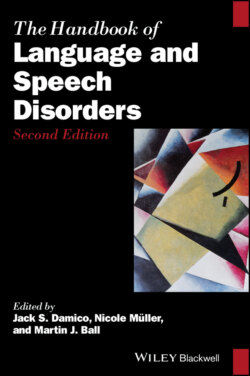Читать книгу The Handbook of Language and Speech Disorders - Группа авторов - Страница 53
3.3.9 Higher‐Order Communication
ОглавлениеWhile a central goal of cochlear implantation is to improve expressive and receptive communication competence and performance of the structure of speech and language, that is, the formal aspects of language, such as phonology and grammar, it is of special interest to study how successfully CI users practice and apply language along with other pragmatic aspects of communication, since that is ultimately what affects quality of life (Fortunato‐Tavares, Befi‐Lopes, Bento, & de Andrade, 2012). This involves skills such as intelligibility, discourse strategies, nonverbal communication and communicative initiative. Fewer studies are devoted to this than to objective language and speech perceptual measures.
Sarant et al. (2018) reviewed research using parental reports showing that, on a general level, cochlear implantation, relative to pre‐implantation, enhances communication skills and social relationships for children suffering from severe to profound hearing loss. A large majority of parents surveyed by Nelson, Herde, Munoz, White, and Page (2017) reported that they were satisfied with their choice of CI for their children because it allowed them to communicate orally with them, their family and the rest of the hearing community. They also indicated that it provided for school performance that could be on par with hearing peers, although hearing in noise was found to be problematic. This motivation for implantation by parents is consistent with other research, although signed communication is seen as a useful support for oral communication (Hyde & Punch, 2011). Advantages have also been reported for adults. Patients over 40 years old reported that implantation had improved their general and physical health, as well as, to a lesser extent, their social interaction (Ramos et al., 2013). Furthermore, in a review, Mayer and Trezek (2017) found that only 3 out of 14 studies observed reduced literacy development in students with CIs.
These merits of implantation do not, however, mean that the everyday communication skills of CI recipients were commensurate with their NH counterparts. For children, they were found to be comparable to those of peers with moderate to severe hearing loss using amplification (Meister et al., 2015). Intelligibility was observed to be reduced and to correlate with measures of psychosocial development, among which functional communication, which was itself impaired (Boonen, Kloots, & Gillis, 2019; Freeman, Pisoni, Kronenberger, & Castellanos, 2017); however, see also Li et al. (2018) and Sarant et al. (2018). Reduced abilities in everyday communication in quiet and in noise were reported for a group of 339 children (Cupples et al., 2018).
Holt et al. (2017) found that adults with CIs, in a task where interlocutors were asked to direct each other around a map, used repetition of directives more often than information requests, as a request for clarification, and also fewer acknowledgments than NH counterparts. Moreover, their final rise excursions for questions, which were normally large, as opposed to statements, which were normally small or non‐existent, was opposite to those of the control participants. This shows that their usage and realization of pragmatics in language was essentially different from NH controls.
The above literature suggests that CIs improve non‐objective higher‐order communication relative to the pre‐implant period, but that many aspects of the pragmatics of communication deviate from those of NH peers. Many issues are yet to be thoroughly investigated. Sarant et al. (2018) argued that impaired prosocial behavior that can be observed in CI children may be due to issues, some of which have been reported, for children with hearing loss, such as reduced access to speech due to, for instance, a late onset of acquisition, difficulty with hearing in noise, poor quality of speech input, reduced amount of overhearing or eavesdropping, reduced child‐directed input or parental attention, increased listening effort, and shame in expressing oneself. Children (n = 188) with delayed expressive and receptive oral language development spent less time communicating with their parents and had reduced sustained attention, as revealed by the percentage of time dedicated to playing, during free play than their NH peers (Barker et al., 2009). According to the authors, the results supported the hypothesis that attention deficits, and not communication skills, mediated the effect of language problems on behavior, which opens up new avenues of investigation for the study of the long‐term effects of cochlear implantation on the higher‐order communication of children.
